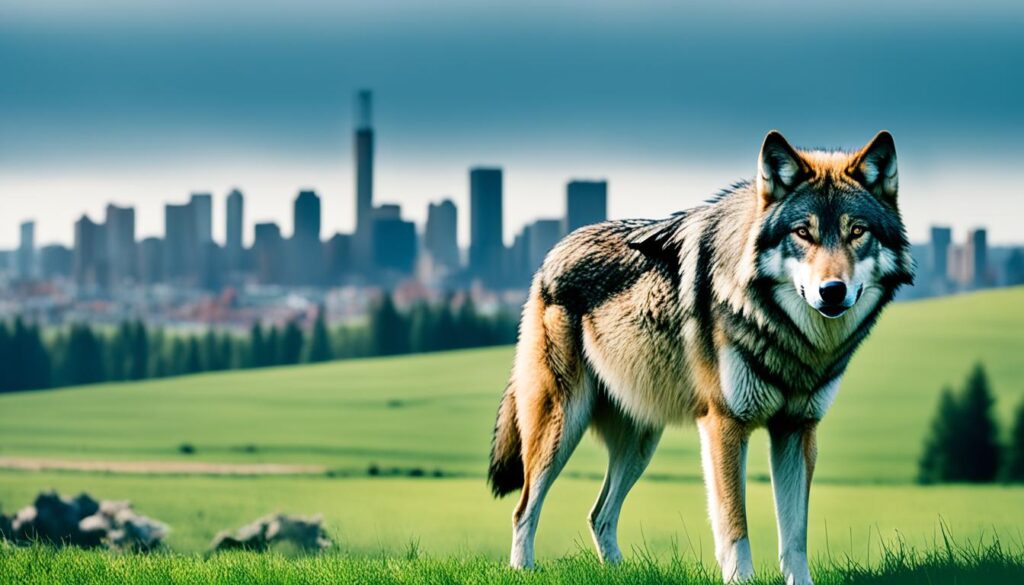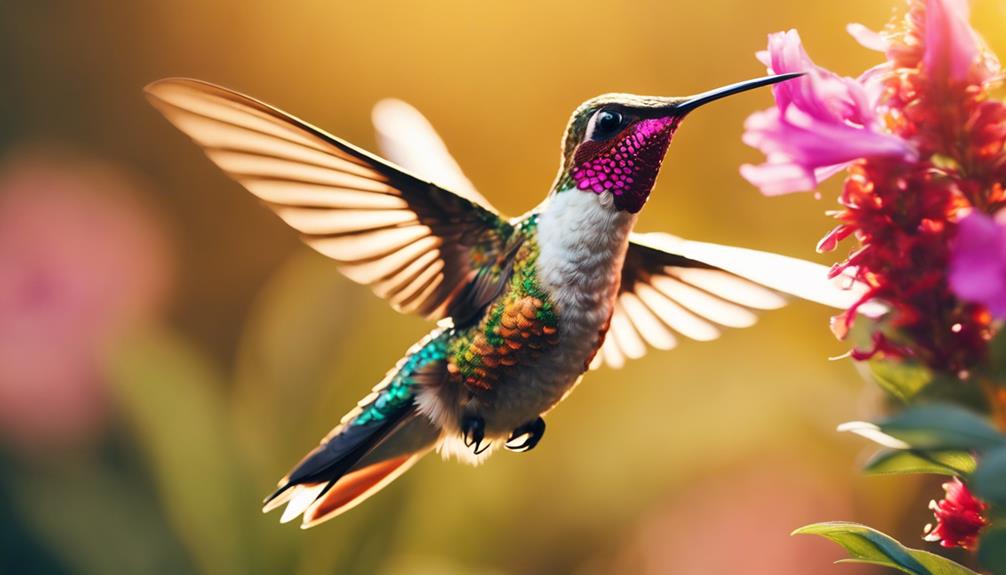Ever heard how people changed their view of wolves? They used to be seen as scary predators but are now admired as noble protectors of nature. This big change shows how cultural symbols are powerful and highlights the complex bond between humans and wolves.
- Wolves were once feared as predators but are now revered as protectors.
- Cultural symbolism has played a significant role in shaping the image of wolves.
- The relationship between humans and wolves is complex and deeply intertwined.
- Understanding the cultural significance of wolves is crucial for promoting coexistence and protecting their existence.
- Wolves serve as a reminder of our own story and hopes as humans.
The Ecological Importance of Wolves as Keystone Species
Wolves, with their widespread distribution from North America to Eurasia, are ecologically vital as keystone species, playing a critical role in maintaining the health and balance of ecosystems. Their presence is paramount to the overall ecosystem health and stability due to their unique behaviors and ecological interactions.
As keystone species, wolves have a profound impact on prey regulation, ecosystem health, and biodiversity. By regulating prey populations, such as deer and elk, wolves help control their numbers, preventing overgrazing and habitat degradation. This prey regulation ensures a balance in the ecosystem, allowing vegetation to thrive and creating healthier habitats for other species.
Furthermore, the presence of wolves fosters a more diverse and resilient ecosystem. Their hunting behavior creates a cascade effect, influencing the behavior and distribution of their prey species. This influence, known as a trophic cascade, results in landscape reshaping and the promotion of greater biodiversity. By controlling the population of herbivores, wolves indirectly benefit smaller species, such as songbirds and rodents, as well as plants and vegetation. This intricate web of interactions contributes to a more balanced and vibrant ecosystem.
Through their ecological roles and interactions, wolves shape the natural environment in transformative ways. They help maintain healthy populations of large herbivores, prevent overgrazing, and promote a diverse array of species. Additionally, their predatory behavior has a direct impact on the behavior and movement patterns of prey, which, in turn, affects the distribution of vegetation and the overall structure of the landscape.
In conclusion, wolves, as keystone species, are crucial for ecosystem health and functioning. Their role in prey regulation, promotion of biodiversity, and landscape reshaping highlights their significance in maintaining a balanced and thriving environment. Protecting and preserving wolf populations is not only imperative for their survival but also for the long-term stability and health of natural ecosystems.

The Cultural Symbolism of Wolves in Folklore and Tradition
Culturally, wolves hold a unique place in the human imagination, revered and mythologized across various cultures for their intelligence, resilience, and spirit of freedom. They are deeply embedded in folklore and tradition, often symbolizing strength and guidance. In many Indigenous communities, wolves have a prominent role in folklore and spiritual beliefs, often revered as ancestral figures, spiritual guides, and symbols of the untamed natural world.
Wolves hold significant cultural symbolism as they embody qualities that humans admire and seek to emulate. Their remarkable strength and ability to survive in harsh environments make them powerful symbols of resilience and endurance. Wolves are known for their strong family bonds and cooperative hunting, representing the value of community and teamwork.
Throughout folklore and tradition, wolves are often portrayed as wise and cunning creatures. Their keen senses and ability to navigate through various landscapes have long been associated with guidance and intuition. In many legends and tales, wolves serve as spiritual guides, leading individuals through challenging journeys and offering protection.
As an integral part of cultural narratives, wolves reflect the human desire for freedom and the wild spirit. In various mythologies and stories, they are portrayed as guardians of nature, protecting the delicate balance of the natural world. Their presence in these narratives reminds us of the interconnectedness between humans and the wilderness.
Across different cultures, the wolf’s image carries both positive and negative connotations. While some societies admire wolves for their strength and resilience, others fear them as dangerous predators. However, the negative perception of wolves often stems from misconceptions and lack of understanding.
Understanding the cultural significance of wolves in folklore and tradition is essential for appreciating their role in shaping human imagination and values. By recognizing their symbolic representations, we gain a deeper appreciation for the intricate relationship between humans and this remarkable creature.
Wolves’ Cultural Symbolism in Key Cultures
| Culture | Symbolism |
|---|---|
| Native American | Guardian and healer; represents loyalty and family ties |
| Norse Mythology | Fenrir, the monstrous wolf, represents chaos and destruction |
| Roman Mythology | Wolf serves as a nurturing figure, as seen in the story of Romulus and Remus |
| Japanese Folklore | Amaterasu, the sun goddess, is often associated with a wolf, representing power and protection |

These examples highlight the diversity of cultural symbolism surrounding wolves and the central role they play in shaping the narratives and values of different societies. By exploring the various interpretations and beliefs associated with wolves, we gain a deeper understanding of the multifaceted relationship between humans and this majestic creature.
Sonja Swift’s Exploration of Wolves and Human Connections in “Echo Loba, Loba Echo”
In her book, “Echo Loba, Loba Echo: Of Wisdom, Wolves, and Women,” Sonja Swift delves into the multifaceted relationship between humans and wolves. Through her insightful exploration, she delves deep into the bond that exists between these two species, their coexistence in the natural world, and the endangerment that threatens their existence today.
Sonja Swift’s work serves as a mirror, reflecting how wolves mirror our own stories, fears, and hopes. Through her vivid storytelling, she invites readers on a captivating journey that reveals the intricate connections between humans and wolves.
“Wolves mirror our own stories, fears, and hopes. In their resilience, strength, and intelligence, we find reflections of our own human spirit.”

With each page turned, Sonja Swift masterfully intertwines the mystical tales of ancient folklore with the plight of wolves in our modern world. Her nuanced perspective not only sheds light on the historical significance of the human-wolf connection but also highlights the urgent need to protect these magnificent creatures and preserve the delicate balance between them and humankind.
The Wisdom of Wolves
Sonja Swift’s poignant narratives illuminate the wisdom inherent in the wolf’s nature, captivating readers with tales of their loyalty, resilience, and unwavering spirit. Through her words, we explore the profound symbiosis between wolves and humans, recognizing that our destinies are intertwined in ways we may have never realized.
Uncovering Shared Stories
Within the pages of “Echo Loba, Loba Echo,” Sonja Swift uncovers the remarkable parallels between human stories and those of wolves. She delves into the emotions, struggles, and triumphs that both species experience, revealing the intricate web of interconnectedness that underscores the human-wolf relationship.
| Chapter | Insights |
|---|---|
| Chapter 1 | The primal bond between humans and wolves throughout history. |
| Chapter 2 | The ways wolves mirror human societal structures and dynamics. |
| Chapter 3 | The spiritual connection between wolves and women. |
| Chapter 4 | The challenges faced by wolves and their human counterparts in the modern world. |
Sonja Swift’s thought-provoking work is an invitation to reflect on our shared narratives and awaken our collective responsibility to protect and cherish the intricate bond between humans and wolves.
The Misunderstanding and Fear of Wolves
Wolves have long been plagued by misunderstanding and fear, perpetuated by misconceptions and projections onto these magnificent creatures. Despite the fact that there have been only a few recorded deaths caused by wolves in the past 100 years in the U.S., a deep-rooted fear of wolves persists. This fear can be attributed to various factors, including misconceptions about their behavior, exaggerated portrayals in popular media, and historical events that have shaped negative perceptions.
One common misconception is the notion that wolves are inherently dangerous to humans. While it is essential to exercise caution and respect when encountering any wild animal, the likelihood of experiencing harm from a wolf is extremely low. In fact, wolves tend to avoid human contact and will generally flee instead of engage in confrontations. The majority of recorded wolf attacks on humans have been the result of rabies, a rare occurrence that further contributes to the fear surrounding these animals.
The fear and distrust of wolves can be traced back to medieval Europe, where they were associated with darkness, danger, and evil. This negative perception was amplified during the colonization era, particularly in North America, as settlers sought to assert dominance over the land and its resources. Wolves were viewed as competitors for prey and as threats to domesticated animals. The slaughter of bison herds alongside wolves contributed to ecological imbalances, leading to starvation and land theft, further fueling the fear and animosity towards these creatures.
Despite the misconceptions and projections onto wolves, it is important to recognize the invaluable role they play in maintaining the balance of ecosystems as keystone species. By regulating prey populations and shaping landscapes, wolves contribute to biodiversity and ecological resilience.

In order to dispel the fear of wolves and foster a greater understanding, it is crucial to educate the public about their true nature, dispel lingering misconceptions, and promote coexistence based on scientific knowledge and ecological awareness. Encounters between wolves and humans should be viewed as rare and extraordinary opportunities to witness the beauty of the natural world, rather than instilling fear and hostility.
Dangers of Portraying Wolves as Demonic
The historical and cultural associations of wolves with evil and danger have had significant repercussions for the conservation of these incredible creatures. By perpetuating the image of wolves as demonic predators, we further alienate them from our understanding and hinder efforts to promote their protection.
Rabies: A Rational Concern
While the fear of wolves is often unfounded, the concern about rabies is legitimate. Rabies is a viral disease that can affect mammals, including wolves. However, it is important to note that the prevalence of rabies in wolf populations is relatively low, making encounters with rabid wolves rare. Education and public health initiatives aimed at reducing the incidence of rabies in wildlife can help alleviate this concern and ensure the safety of both humans and animals.
| Common Misconceptions About Wolves | Realities About Wolves |
|---|---|
| Wolves are bloodthirsty killers that pose a constant danger to humans. | Wolves typically avoid human contact and are more likely to flee than engage in aggressive behavior. |
| Wolves are responsible for numerous deaths of livestock and pets. | The majority of livestock losses are due to non-predatory causes, such as disease or inadequate husbandry practices. |
| Wolves decimate prey populations and disrupt ecological balance. | Wolves play a crucial role in maintaining healthy ecosystems by regulating prey populations and shaping landscapes. |
| Wolves are carriers of rabies and pose a significant risk to public health. | While rabies is a legitimate concern, the prevalence of rabies in wolf populations is relatively low, making encounters with rabid wolves rare. |
| Wolves are a threat to human safety and should be eradicated. | Wolves are a vital part of our natural heritage and their conservation is essential for maintaining healthy ecosystems. |
The Dire Situation for Wolves in Idaho
The conservation efforts for wolves in Idaho face numerous challenges, stemming from public sentiment and ecological awareness. Despite the vital role that wolves play in maintaining the balance of ecosystems, there is resistance and opposition, particularly from rural areas. The lack of public awareness regarding the ecological importance of wolves further exacerbates the situation.
In order to improve the plight of wolves in Idaho, it is crucial to raise public awareness about their significance in the health of ecosystems and the need for their conservation. This can help broaden the constituency for their protection and garner support for conservation efforts. However, achieving this goal is not without its difficulties.
One significant challenge is the prevalence of political narratives that portray wolves negatively, often blaming them for the decline of prey animals and the economic challenges faced by certain communities. These narratives can fuel hostility towards wolves and hinder conservation efforts.
Moreover, rural sentiments often reflect a lack of ecological awareness, leading to a disregard for the importance of maintaining healthy ecosystems. It is essential to bridge the gap between rural communities and conservation advocates, fostering understanding and promoting the value of wolves in ecological balance.
To address these challenges, conservation organizations and policymakers must develop strategies that emphasize the ecological and economic benefits of wolves. By highlighting the positive impacts of wolves on biodiversity and tourism, it may be possible to overcome rural sentiments and garner greater support for their conservation.
Public Awareness and Education
An effective approach to improving the dire situation for wolves in Idaho is through public awareness and education campaigns. These initiatives should aim to dispel misconceptions surrounding wolves and emphasize their ecological importance.
Conservation organizations can collaborate with schools, community centers, and local media to provide accurate information about wolves and their role in maintaining the health of ecosystems. By engaging with the public through presentations, workshops, and informative materials, it is possible to cultivate a greater understanding and appreciation for these magnificent creatures.
Additionally, wildlife tourism can play a significant role in raising public awareness and generating support for wolf conservation efforts. By organizing guided tours, workshops, and educational events focused on observing and learning about wolves in their natural habitat, individuals can develop a firsthand appreciation for their ecological significance.
Building Bridges and Fostering Dialogue
To overcome the challenges and opposition surrounding wolf conservation, it is crucial to build bridges and establish meaningful dialogue between stakeholders. This includes engaging with rural communities, local businesses, and livestock owners to address their concerns and find mutually beneficial solutions.
Conservation organizations and government agencies can work collaboratively with rural communities to develop programs that promote coexistence and enhance livestock protection practices. By providing resources, such as funding for non-lethal deterrents and compensation for livestock losses, it is possible to alleviate some of the economic burdens faced by ranchers while simultaneously protecting wolves.
Fostering dialogue and promoting a collaborative approach can also help dispel misconceptions and address the fears and anxieties associated with wolves. By facilitating open and respectful conversations, it becomes possible to find common ground and develop strategies that balance the needs of both humans and wolves.

| Challenges | Solutions |
|---|---|
| Rural sentiments opposing wolf conservation | Engage with rural communities, promote coexistence, and provide support for livestock protection |
| Lack of public awareness | Implement public awareness and education campaigns, collaborate with schools and local media |
| Political narratives blaming wolves | Highlight the positive impacts of wolves on ecosystems and local economies |
| Misconceptions and fears | Foster dialogue, dispel misconceptions, and address concerns through open conversations |
The Return of Wolves to Europe
In recent years, wild animals such as wolves have started to repopulate the cultural landscapes of Western Europe, from which they went extinct centuries ago. The spontaneous return of these wild animals sheds new light on the relationship between humans and wild animals.
Wolves have been able to repopulate areas where they had disappeared earlier, showcasing the process of rewilding. This reestablishment of wolf populations in Western Europe signifies a significant milestone in the conservation of these charismatic predators and the restoration of natural ecosystems.
Rewilding Western Europe: A Triumph for Wolf Populations
The return of wolves to Western Europe symbolizes the triumph of conservation efforts and highlights the resilience of these magnificent creatures. It is evidence of the potential for repopulating cultural landscapes with species that once flourished in the region.
Cultural landscapes in Western Europe, encompassing diverse habitats and human-influenced environments, provide an opportunity for wildlife to reclaim their natural territories and thrive. The return of wolves signifies a step towards ecological balance and the restoration of natural processes within these landscapes.
Rewilding initiatives, supported by conservation organizations and local communities, aim to reestablish healthy and self-sustaining ecosystems by reintroducing keystone species like wolves. These initiatives not only benefit the wolves themselves but also contribute to the preservation of biodiversity and the overall health of the environment.

The Role of Wolves in Shaping Cultural Landscapes
Wolves play a crucial role in shaping cultural landscapes by influencing prey populations and their behavior. The presence of wolves can result in the ecological restoration of certain habitats, as the fear of predation alters the feeding patterns and movements of prey species.
This, in turn, leads to changes in vegetation growth patterns and the overall structure of the landscape. The return of wolves to Western Europe not only impacts the ecological balance but also contributes to the cultural identity and heritage of the region.
A Call for Coexistence and Conservation
The return of wolves to Western Europe presents an opportunity for humans to redefine their relationship with these apex predators. Coexistence with wolves requires a shift in perspective, recognizing their value as integral components of healthy ecosystems and embracing the shared responsibility for their conservation.
With proper management strategies, including the implementation of non-lethal measures to reduce conflicts between wolves and human activities, it is possible to strike a balance between preserving cultural landscapes and safeguarding the interests of local communities.
By actively engaging in dialogue and collaboration, stakeholders can work towards establishing harmonious relationships between humans, wolves, and the environment. This holistic approach is essential for the long-term survival of wolf populations and the preservation of Western Europe’s unique cultural and natural heritage.
Social Tensions and Debates Surrounding Wolves
The return of wolves often sparks social tensions and ignites passionate debates among different communities. While some celebrate the wolf’s return as a triumph of nature conservation policies, highlighting their positive impact on biodiversity, others express concerns regarding the safety of humans and livestock. Surveys conducted in the Netherlands indicate that attitudes towards wolves have remained relatively stable since their reintroduction, with the majority adopting a pragmatic approach that combines a willingness to coexist with caution about potential risks.
The coexistence of wolves and humans is a complex issue that requires a moderate and balanced approach. Supporters of the wolf’s return emphasize their ecological value as keystone species, arguing that their presence contributes to healthy and balanced ecosystems. They highlight the crucial role wolves play in regulating prey populations, which helps maintain the overall balance of the ecosystem.
However, those who express concerns about the wolf’s return focus on the potential conflicts that arise in areas where wolves and human activities intersect. Farmers, in particular, worry about the safety of their livestock and the economic impact of wolf predation. These concerns are rooted in the historical perception of wolves as a threat and the fear of potential losses. Developing effective strategies for coexistence requires understanding the perspectives of all stakeholders involved, as well as implementing scientifically informed measures to mitigate conflicts.
“The challenge lies in finding a middle ground where both the needs and interests of humans and wolves are taken into account. It requires ongoing dialogue and collaboration among scientists, policymakers, and communities to address these social tensions and promote sustainable coexistence.”
A Pragmatic Attitude Towards Coexistence
The Dutch population’s attitudes towards wolves have revealed a pragmatic perspective on the issue. While some individuals express concerns and reservations, the majority demonstrate a willingness to coexist with wolves, recognizing their ecological value. This moderate approach seeks to find a balance between preserving biodiversity and addressing the potential risks associated with wolf presence.
Surveys and studies have shown that public awareness and education play a crucial role in shaping attitudes towards wolves. When provided with accurate information about wolf behavior, the benefits they bring to ecosystems, and strategies for coexistence, individuals are more likely to adopt a pragmatic and informed perspective.
Addressing Concerns and Mitigating Risks
To ease social tensions and promote coexistence, it is essential to address the concerns and risks associated with the wolf’s return. This requires implementing effective measures that minimize conflicts between wolves and human activities, particularly in areas where livestock is present.
Livestock protection strategies, such as the use of guard dogs, fencing, and improved animal husbandry practices, can significantly reduce the likelihood of wolf predation on livestock. Furthermore, providing compensation to farmers for any losses incurred can alleviate some of the economic burden associated with the wolf’s presence.
Collaboration and communication among scientists, policymakers, conservation organizations, and local communities are crucial for developing and implementing successful mitigation strategies. By working together, it is possible to find innovative solutions that promote a harmonious coexistence between humans and wolves.

| Attitudes Towards Wolves | Percentage |
|---|---|
| Supportive of wolves and their ecological value | 45% |
| Concerned about the safety of humans and livestock | 35% |
| Pragmatic approach, willing to coexist with caution | 20% |
Wolf Predation on Livestock and Shepherding Practices
Wolf predation on livestock, particularly sheep, poses a significant concern for sheep farmers. The presence of wolves can result in the loss of valuable livestock and impact the economic viability of shepherding operations. To mitigate these risks, farmers have had to adapt their shepherding practices and implement measures to protect their livestock.
One effective method of livestock protection is the use of guard dogs or flock-protection dogs. These specially trained canines serve as a deterrent to wolves and other predators, actively patrolling the flocks and alerting shepherds to potential threats. Guard dogs have proven to be an invaluable asset in minimizing the risk of wolf predation and ensuring the safety of the livestock.
Additionally, increased monitoring has become an essential component of shepherding practices. Farmers are employing various tracking technologies, such as GPS collars, to keep a close eye on their flocks’ movements and detect any potential signs of wolf activity. This proactive approach enables shepherds to respond swiftly and implement protective measures to prevent or minimize losses due to wolf predation.
“The integration of guard dogs and advanced monitoring technologies in shepherding practices has played a crucial role in mitigating the risks of wolf predation, ensuring the coexistence of sheep farmers and wolves,” states John Peterson, a renowned expert in livestock protection.
While some argue that the presence of wolves can have positive effects on shepherds, such as creating job opportunities in wolf tourism or promoting the renovation of mountain huts to accommodate visitors, others view their return as a challenge. For many farmers, shepherding has become more time-consuming and less cost-effective due to the increased efforts required to protect their flocks from wolf predation.
Despite the challenges, fostering coexistence between wolves and sheep farmers is crucial for promoting sustainable wildlife management. Balancing the needs of both wildlife conservation and agricultural livelihoods requires ongoing dialogue, adaptive strategies, and support for affected farming communities.
Sheep Farmers’ Perspectives on Wolf Predation
To gain a deeper understanding of the impact of wolf predation on sheep farmers, a survey conducted by the National Sheep Association (NSA) explored the sentiments and experiences of farmers in regions with wolf populations. The findings revealed a range of perspectives:
- 1. Concern for Livestock losses: The majority of sheep farmers expressed concerns about the potential losses caused by wolf predation. They highlighted the economic strain and emotional toll resulting from these losses.
- 2. Need for Effective Livestock Protection: Many farmers emphasized the importance of implementing effective livestock protection strategies to minimize the risk of wolf predation. They called for support and resources to enhance their capacity to protect their flocks.
- 3. Coexistence and Conservation: Some farmers recognized the ecological significance of wolves and acknowledged the importance of coexistence. They advocated for a balance between conservation efforts and measures to mitigate the impact on their farming operations.
The perspectives shared by sheep farmers underscore the complexity of the issue and the need for collaborative solutions that address both livestock protection and conservation objectives.
| Farmers’ Perspectives | Percentage |
|---|---|
| Concern for Livestock losses | 65% |
| Need for Effective Livestock Protection | 82% |
| Coexistence and Conservation | 43% |

Sheep farmers across regions affected by wolf predation are navigating the challenges posed by coexisting with wolves. By implementing improved shepherding practices and support from relevant authorities, we can work towards finding sustainable solutions that ensure both the protection of livestock and the conservation of wolf populations.
The Cultural Conflict About Wolves
The cultural conflict surrounding wolves encompasses a range of perspectives and attitudes, shaped by diverse cultural and socio-economic factors. On one side, there are those who recognize the vital role wolves play in maintaining ecosystem balance and advocate for coexistence. They acknowledge the ecological benefits that wolves bring, such as regulating prey populations and shaping landscapes.
However, on the other side, there are those who view wolves as a threat to their way of life and livelihood. This perspective often stems from concerns about wolf predation on livestock and the perceived competition for resources. It can also be influenced by cultural beliefs, including the fear or aversion, known as lupophobia, that some individuals or communities hold towards wolves.
This cultural conflict is often exacerbated by extreme voices dominating the debate, leading to polarization and a lack of unified vision for wolf management. In some cases, individuals with a trophy mentality see wolf hunting as a sport or status symbol rather than acknowledging the ecological consequences of indiscriminate killing.
The cultural conflict surrounding wolves is not simply a matter of environmental conservation or economic interests; it is an intersection of deeply ingrained values, fears, and identities. To address this conflict, we need to bridge divides and foster understanding, empathy, and an ecological perspective.
Cultivating Coexistence: Finding Common Ground
Creating a harmonious coexistence between humans and wolves requires exploring holistic solutions that consider both ecological and socio-economic factors. By promoting education and public awareness campaigns, we can debunk myths, challenge misconceptions, and foster a deeper understanding of the essential role wolves play in ecosystems.
Additionally, fostering dialogue and collaboration between different stakeholders, including wildlife conservation organizations, farmers, and local communities, can lead to more effective strategies for managing conflicts and finding mutually beneficial solutions.
Striking a Balance: Ethical Wolf Management
Ethical wolf management goes beyond the extremes of either eradication or absolute protection. It involves implementing measures that prioritize the conservation of the species while ensuring the safety and well-being of both humans and animals.
One approach to achieving this balance is through the implementation of non-lethal methods to mitigate wolf-human conflicts. These may include the use of livestock guardians, secure enclosures, and compensation programs for farmers affected by wolf predation.
Furthermore, hunting policies can be reevaluated to focus on sustainable practices that prioritize the long-term viability of wolf populations and the preservation of ecological integrity. This shift towards an empathetic hunting ethic recognizes the need for responsible management and acknowledges the intrinsic value of all living beings.

The Way Forward: Unity and Ecological Perspective
To overcome the cultural conflict surrounding wolves, it is essential to foster unity and promote an ecological perspective that values the interconnectedness of all life forms. Recognizing the importance of biodiversity, ecosystem balance, and the intrinsic value of wolves is crucial for building a sustainable future.
Through open-mindedness, dialogue, and a willingness to find common ground, we can navigate the complex cultural landscape that surrounds wolves. It is only by embracing empathy, understanding, and a shared ecological vision that we can achieve true coexistence and ensure the long-term survival of these majestic creatures.
| Attitude | Perspective |
|---|---|
| Advocacy for Coexistence | Recognition of wolves’ ecological importance and the need for harmonious coexistence |
| Threat Perception | Viewing wolves as a threat to human safety, livestock, and economic interests |
| Lupophobia | Fear or aversion towards wolves based on cultural beliefs |
| Trophy Mentality | Viewing wolf hunting as a sport or status symbol, disregarding ecological consequences |
The Status and Plight of the Wolf
The status and plight of the wolf reflect the spiritual and ethical corruption of a society driven by self-interest and the exploitation of nature. Despite their ecological importance as keystone species, wolves face many challenges due to human activities and misconceptions.
Wolf protection is vital for the preservation of biodiversity and ecosystem health. However, the debate surrounding wolf hunting often perpetuates a trophy hunting mentality, where the focus is on the thrill of the kill rather than the conservation of species.
To ensure the long-term survival of wolves, it is crucial to prioritize species conservation efforts and promote an empathetic hunting ethic. Recognizing the importance of predators, such as wolves, in maintaining healthy ecosystems is essential for achieving a balanced coexistence between humans and wildlife.
Building a truly civilized society requires unity and a moral sensibility that respects all life and the natural environment. By advocating for wolf protection and embracing an empathetic hunting ethic, we can help preserve the delicate harmony of our ecosystems and ensure the survival of these magnificent creatures for future generations.
Wolves: A Keystone Species
Wolves play a critical role as keystone species in maintaining the health and balance of ecosystems. Their presence helps regulate prey populations, preventing overgrazing and preserving the overall biodiversity of an area.
“The presence of wolves is a crucial factor in shaping landscapes and maintaining ecological stability. Their predatory behavior ensures that ecosystems remain in a healthy state, promoting the coexistence of diverse plant and animal species.”
Protecting wolves not only safeguards their population but also contributes to the conservation of other species and the preservation of intact natural environments.
| Issue | Current Status |
|---|---|
| Wolf Protection | Inconsistent and contentious |
| Trophy Hunting | Perpetuates a harmful mentality |
| Species Conservation | Requires greater emphasis |
| Empathetic Hunting Ethic | Needs broader recognition |

Conclusion
The wolf holds immense cultural significance, embodying both the role of a feared predator and a revered protector. This magnificent creature plays a critical ecological role as a keystone species, contributing to the health and balance of ecosystems. Moreover, wolves hold a unique place in the human imagination, symbolizing strength, resilience, and the untamed spirit of the natural world.
Understanding the cultural symbolism, challenges, and debates surrounding wolves is essential for fostering coexistence and safeguarding their existence. The journey of the wolf from predator to protector mirrors our own story as humans, reflecting our evolution from a place of fear and misunderstanding to one of appreciation and respect. By recognizing the cultural significance of wolves, we can deepen our connection to these extraordinary creatures and ensure their preservation for future generations.
As we navigate the complexities of this relationship, it is crucial to acknowledge the crucial role that wolves play in maintaining the delicate balance of ecosystems. By embracing a holistic approach that respects both the cultural and ecological aspects, we can foster a harmonious coexistence between humans and wolves. Through education, collaboration, and conservation efforts, we have the power to protect the wolf and honor its journey from feared predator to revered protector.
FAQ
Are wolves really important for ecosystems?
Why are wolves revered and mythologized in various cultures?
What does Sonja Swift’s book, “Echo Loba, Loba Echo” explore?
Why are wolves feared and misunderstood?
What is the situation for wolves in Idaho?
Are wolves returning to Europe?
What are the social tensions and debates surrounding wolves?
How can livestock be protected from wolf predation?
What is the cultural conflict about wolves?
What is the status and plight of the wolf?
What is the cultural significance of the wolf?
How Do Different Cultures View Wolves as Protectors in Their Cultural Storytelling?
In various cultural storytelling traditions, wolves are often portrayed as protectors through personification in cultural storytelling. Native American tribes look to the wolf as a symbol of loyalty and strength. In Japanese folklore, the wolf is revered as a guardian spirit. The ways in which different cultures view wolves as protectors are deeply rooted in their storytelling traditions.











